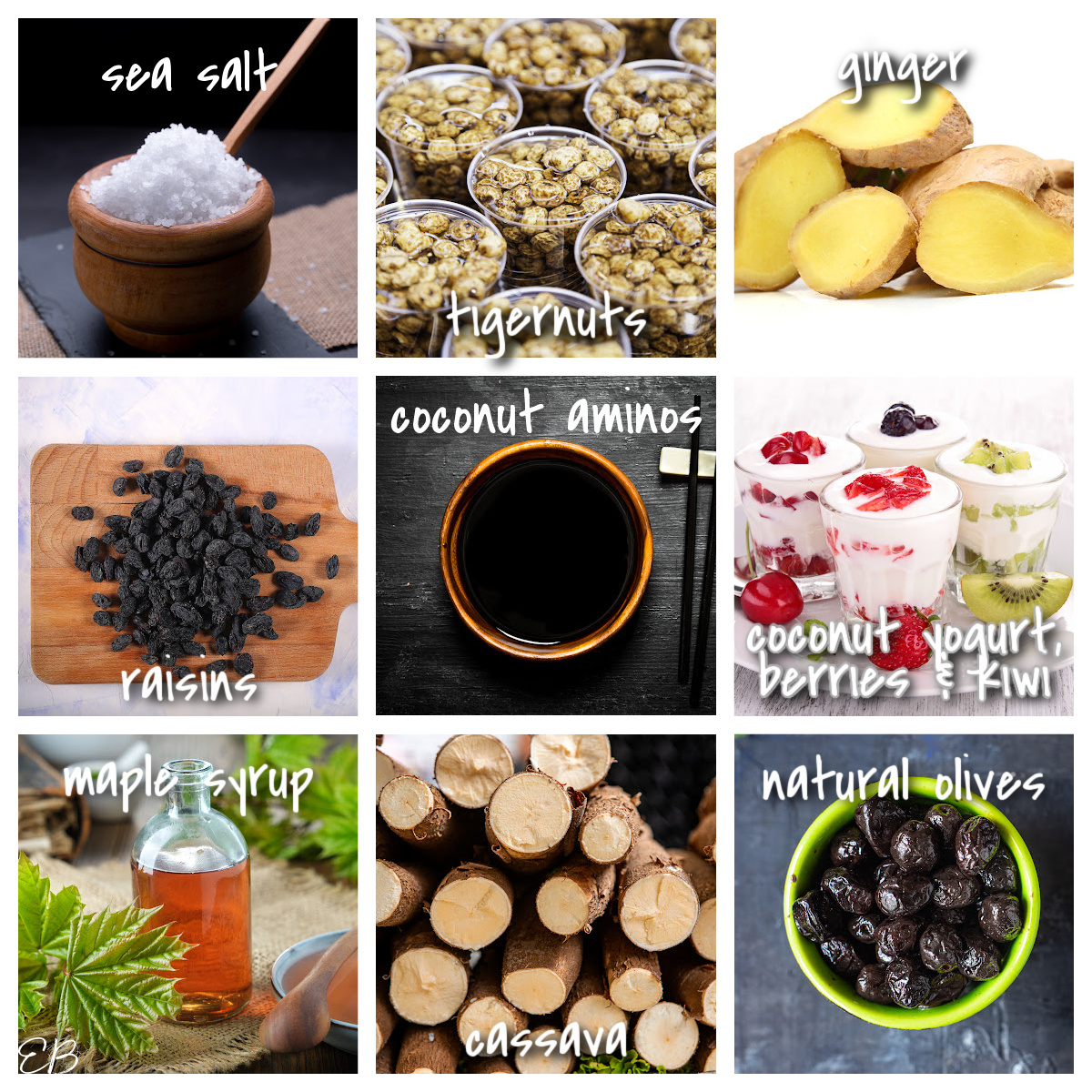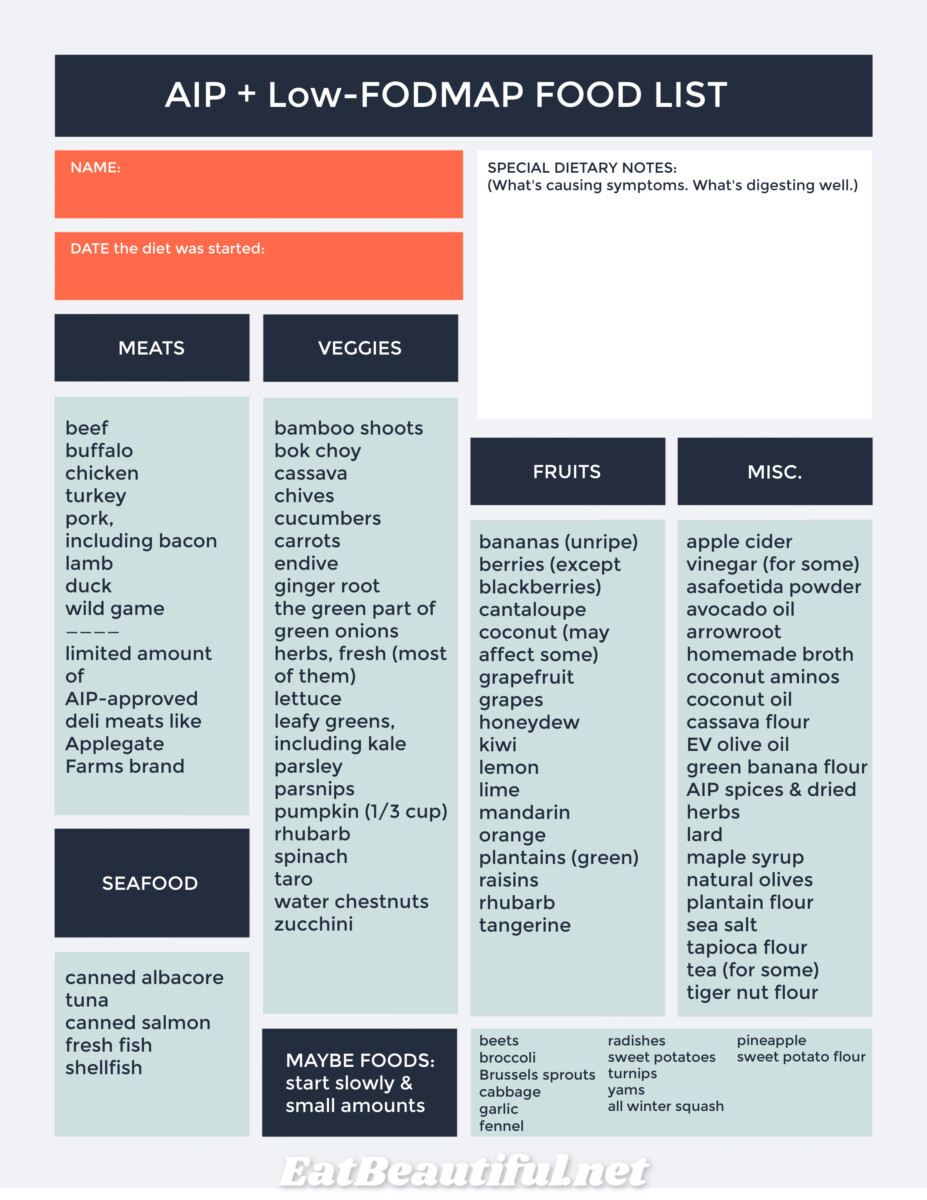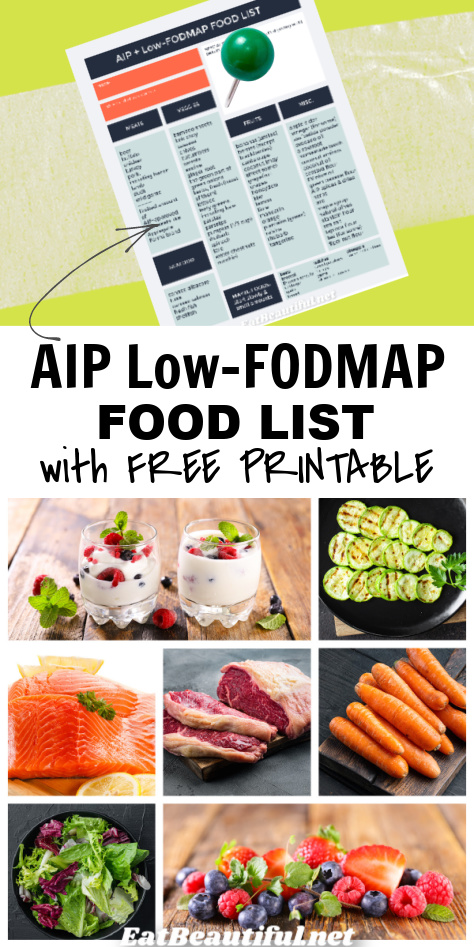I may receive a commission if you purchase through links in this post. I am not a doctor; please consult your practitioner before changing your supplement or healthcare regimen.
The following AIP Low-FODMAP Food List serves as a guideline for daily eating and grocery shopping. Use the free printable to post a list of compliant foods where it’s easy to see. Bring it with you to the grocery store, or use it to create your shopping list.
You can even make notes on it about which foods are causing symptoms or which foods are digesting well.
I find the hardest part of doing a diet like this is: getting an accurate list. It can be confusing how the Low-FODMAP lists vary.
I have tried to make this the most complete list of AIP Low-FODMAP foods available. I’d like this resource to be comprehensive and to provide the most foods possible to enjoy.

What is the point of an AIP Low-FODMAP diet
The AIP diet is an elimination diet, designed to reduce inflammation and reverse autoimmunity.
To learn in detail about what a low-FODMAP diet is, read this article. In short, FODMAP stands for Fermentable, Oligo-, Di-, Mono-saccharides And Polyols.
It consists of groups of certain types of carbohydrates that cause GI symptoms. The Low-FODMAP diet is an elimination diet that’s often effective for treating gut-related symptoms.
I used a Low-FODMAP diet for one year, but I saw improvements in my symptoms and reintroduced some foods after just 2 weeks. So FODMAP eating is very productive and encouraging.
Having been there, I know what it’s like to reintroduce super small amounts of certain foods … and to have to wait on other foods for a long time before reintroducing. Yet, I love that this diet can truly bring improvement so quickly.
For me, I needed to address bloating.
You may choose an AIP Low-FODMAP diet for a combination of symptoms, including autoimmune related issues, inflammation, gas, constipation, diarrhea, bloating or stomach pain.
AIP Low-FODMAP Food Lists
One thing that’s important to note is individual bodies vary in their reactions to foods. But certain foods are the ones that will cause bloating or other symptoms, if there’s going to be an issue.
Under the Vegetables heading, I have listed veggies that are definitely okay, and others to eat in smaller amounts and to gauge if they’re right for you.
Personally, I had some produce items I could eat in small measure or reintroduce on the sooner side and other veggies that I had to wait a whole year before I could reintroduce.
So listen to your body, and use the list as your guide. If you’d like to know how to start an AIP Low-FODMAP diet, just look below the food lists for some quick tips.
AIP Low-FODMAP Meats
Organic or pasture-raised meat: beef, buffalo, chicken, duck, turkey, pork, including bacon, lamb
Seafood: canned albacore tuna, canned salmon, fresh fish, shellfish
AIP Deli meats in smaller quantities: Applegate farm cured meat (nitrate-free, humanely raised). Pederson’s Farms and Hempler’s may also be fine for you. Try them in small amounts. This category of meats is not usually on Low-FODMAP food lists, but I really like to help people find realistic solutions to their food restrictions, and I had no symptoms with these.
So, again, try them in small amounts, or try reintroducing them after 2 to 6 weeks, and see how you do.
Feel free to leave a comment in the Comments section below this article to share your experience.

AIP Low-FODMAP Vegetables
Don’t overdo any of these veggies individually, unless you first look them up and find there are no issues with larger amounts. Many of them are more appropriate in a medley of vegetables. For example, up to half a cup of cooked bok choy is gentle, but more is not.
- bamboo shoots
- bok choy
- cassava
- chives
- cucumbers
- carrots
- endive
- ginger root
- the green part of green onions
- herbs, fresh (most of them)
- lettuce
- leafy greens, including kale
- parsley
- parsnips
- pumpkin (1/3 cup or less)
- radicchio
- rhubarb
- spinach
- taro
- water chestnuts
- zucchini
Foods that work for some people or in smaller amounts, so start slowly on these (after 2 to 6 weeks):
- beets (only very small amounts)
- broccoli
- Brussels sprouts
- cabbage
- fennel
- garlic (only small amounts)
- okra
- radishes
- sweet potatoes
- turnips
- yams
- all winter squash
AIP Low-FODMAP Fruits
All fruits should be eaten in moderation on this combined diet.
- bananas (need to be unripe)
- berries (except blackberries)
- cantaloupe
- coconut (may affect some, so observe to see how you do)
- grapefruit
- grapes
- honeydew
- kiwi
- lemon
- lime
- mandarin
- orange
- plantains (green)
- raisins
- rhubarb
- tangerine
Maybe foods:
- pineapple
AIP Low-FODMAP Miscellaneous foods
- apple cider vinegar (for some)
- arrowroot
- asafoetida powder (great alternative to garlic and onion powders)
- avocado oil (unrefined)
- homemade broth
- cassava flour
- coconut aminos
- coconut oil (unrefined)
- coconut yogurt
- extra-virgin olive oil
- if it’s successfully reintroduced on AIP: ghee
- green banana flour
- lard
- most AIP-compliant spices and dried herbs, as long as they are pure (no other ingredients)
- maple syrup
- natural olives only (no ferrous gluconate, no vinegar, just olives, salt and olive oil)
- onion powder (small amounts of dried onion may be okay for some)
- plantain flour
- red palm oil (sustainably harvested)
- sea salt (must be “sea salt”)
- tapioca flour
- tea (for some)
- tiger nut flour
- tiger nut yogurt
Maybe foods:
- sweet potato flour (in small amounts)
How to start an AIP Low-FODMAP diet
Start this combo diet for 2 to 6 weeks. During that time, you will likely see some encouraging improvements if high-FODMAP foods are a problem for you.
After that, you’ll be able to try adding in a few foods, one a time, in small amounts. Give each new food 3 days, to be sure of symptoms, before trying to increase that food or before trying another new food.
You might also like to use Monash University’s app (here), which can be helpful for low-FODMAP information, if you already know or have a list of AIP guidelines.
Print the Free AIP Low-FODMAP Food List HERE.

You can Pin this post here:


Vicki Lindquist says
I have been on an AIP diet for over two years due to Hashimoto’s thyroidist and hypoglycemia. It’s been a costly journey, but I’m feeling so much better!
I need to focus on reintroduce foods and would appreciate a plan to move forward..What do you suggest?
Megan says
Hi Vicki, if you’d like to consult, you can certainly email me at [email protected] Otherwise, if you are looking for more casual tips, I’d plug into an AIP Facebook group for support. Congrats on feeling so much better, yay!!!
Stephanie Crabtree says
What can I use instead of yogurt or milk to make a fruit smoothie that doesn’t include any for of coconut? I’m highly allergic. What about a vegetable type smoothie? I’m new to all of this. Also, what is the best sweetener besides maple syrup as I’m also allergic to it. No bananas either.
Megan says
Hi Stephanie, surprisingly, water can be used in smoothies! Or a mild bone broth. Or tiger nut milk. For vegetables, I like cooked carrots best. Cook fully in small slices or chunks, then freeze. Wonderful blended with fresh ginger. Cooked beets are also good, and nice combined with berries. You could sweeten any smoothie with cooked sweet potato or soaked and plumped up raisins. Over time your palate will require less sweetener.
Patrick says
Can I eat tapioca in this diet? Isn’t high fodmap?
Megan says
Hi Patrick, Tapioca is a low-FODMAP food. Don’t overdo quantities, but yes, it is allowed.
Cath says
Hi Megan
This is wonderful and comprehensive website and resource Thsnkyou !
Hmm I’m deciding between SCD /low fodmaps or AIP /low fodmaps .. without expensive testing to totally clarify what is going on . Many years ago the SCD diet ( no starch ) helped . These days my kids are teens and while have the right attitude abd accept diet and symptoms link , a strict diet requires commitment and willingness to say no to foods when out with friends or be fussy . I can revisit it though . How will i decide which .. predominant symptoms bloating , awful feeling, IBS-C , foggy mind , fatigue, low mood on flare ups , irritability – easy to stress on flare ups
Megan says
Hi Cath, sorry for your symptoms, and Low FODMAP sounds like it will be helpful. For diet, I’d personally lean towards the low vitamin A diet most, because it also addresses liver health and copper toxicity. Sounds like you could have copper issues. The doctor associated with it does testing for mineral levels, which is very helpful. I waited years for the testing personally, because I didn’t want to budget it in, but ended up finding it very helpful, so think it’s wise to do it sooner if you can. If you’d rather do SCD or AIP, I like the starches included in AIP: cassava, tiger nut etc, to protect the thyroid. But I’d do a low vitamin A version. In other words, no liver or organ meats and not eating the “rainbow” or brightly colored veggies, or sweet potatoes (high in copper). While all this may seem odd, I’ve spent years being on, working with clients and researching “all the diets”, and the low vitamin A comes up as truly hitting the root cause and helping with recovering from symptoms the most. SCD and AIP help a lot because of the anti-inflammatory benefits, but the high A and high copper foods can lead to new issues or unresolved ones IMO. This is Dr. Smith’s website: https://nutritiondetective.com/ (and he has a great support network of patients that’s included) and here’s an intro to the low A diet: https://eatbeautiful.net/vitamin-a-detox-diet-free-printable-food-lists-avoid-eat-toxicity/ Blessings, and best wishes for your recovery!
Kala says
Hi, I see that your delicious tigernut yogurt is listed as approved food on FODMAP – is that correct and how much is allowed daily? Thank you!
Megan says
Hi Kala, yes, that’s right. Quantity with FODMAP foods is individual, so it’s best to start with a small portion to test tolerance, and increase to a full serving as tolerated. If you want to make the Tiger Nut Yogurt even lower FODMAP, you might also be able to sub the sweet potato for yam, which is lower, but either way, the recipe is low FODMAP as-is. I hope it works for you!